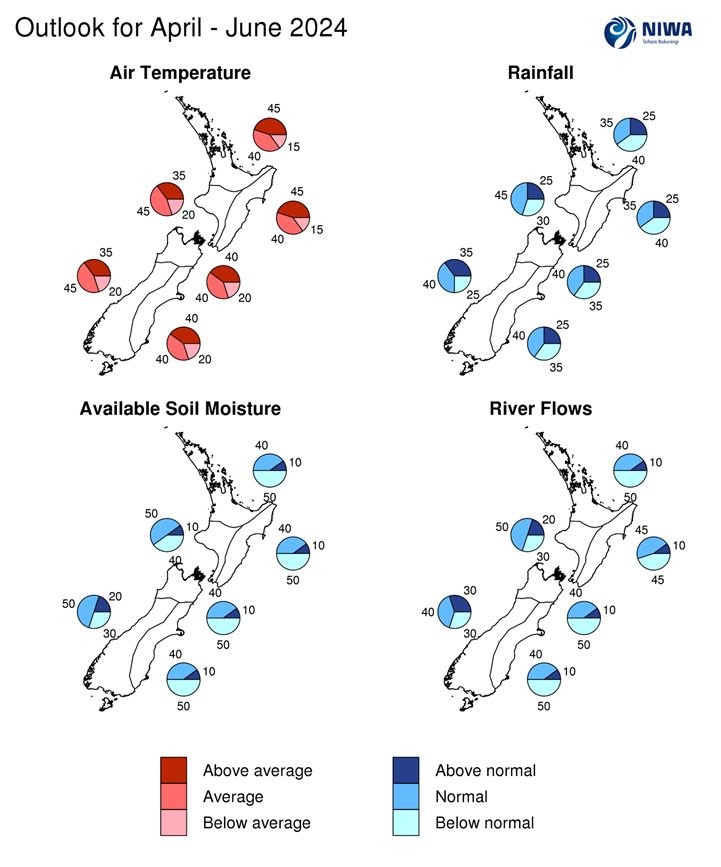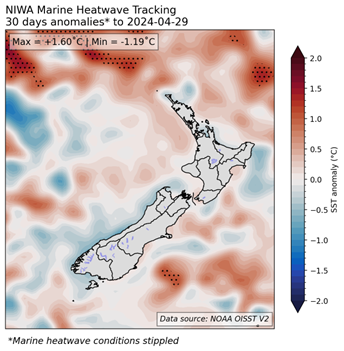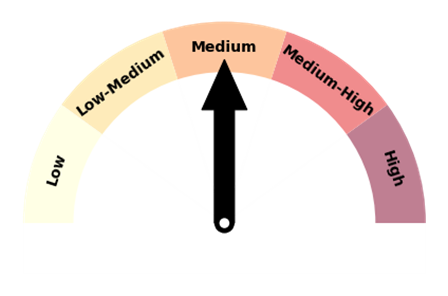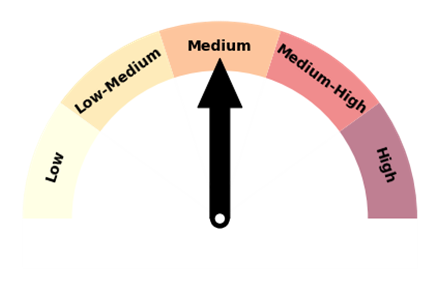Outlook Summary
- El Niño is expected to ease to ENSO neutral by the end of May.
- However, global atmospheric patterns favour a continuation of higher than normal air pressure around New Zealand, particularly near the North Island.
- May is expected to feature rounds of chilly, southerly quarter winds before a transition to milder, westerly quarter winds from late in the month into June and July.
- Rainfall is most likely to be below normal in the north of the North Island and east of the South Island, near normal in the west of the South Island, and about equally likely to be near normal or below normal in all remaining regions. Monitor NIWA35 for updates.
- Because of the prevalence of high pressure, rainfall events will likely occur irregularly. Soil moisture deficits and long-term dryness will continue to be slow to be alleviated.
- Temperatures are about equally likely to be near average or above average in all regions of the country. Despite this, a cold start to the three month period is expected in May followed by a possible trend toward milder conditions in June and July.
- Coastal sea surface temperatures (SSTs) ranged from 0.35˚C below average to 0.11˚C above average during April.
- Soil moisture levels are most likely to be near normal in the west of both islands and most likely to be below normal in all remaining regions.
- River flows are most likely to be near normal in the west of both islands, equally likely to be near normal or below normal in the east of the North Island, and most likely to be below normal in all remaining regions.
Regional predictions for May – July 2024
The tables below show the probabilities (or percent chances) for each of three categories: above average, near average, and below average. In the absence of any forecast guidance there would be an equal likelihood (33% chance) of the outcome for any of the three categories. Forecast information from local and global guidance models is used to indicate the deviation from equal chance that is expected for the coming three-month period. All outlooks are for the three months as a whole. There will inevitably be relatively wet and dry days, and hot and cold days, within a season. The exact range in temperature and rainfall within each of the three categories varies with location and season. However, as a guide, the “near average” or middle category for the temperature predictions includes deviations up to ±0.5°C for the long-term mean, whereas for rainfall the “near normal” category lies between 80 per cent and 120 per cent of the long-term (1991-2020) mean.
Northland, Auckland, Waikato, Bay of Plenty
- Soil moisture levels and river flows are most likely to be below normal (50% chance). Soil moisture deficits will be slow to be alleviated.
| Temperature | Rainfall | Soil moisture | River flows | |
| Above average | 40 | 20 | 10 | 10 |
| Near average | 40 | 35 | 40 | 40 |
| Below average | 20 | 45 | 50 | 50 |
Central North Island, Taranaki, Whanganui, Manawatu, Wellington
Probabilities are assigned in three categories: above average, near average, and below average.
- Temperatures are equally likely to be near average or above average (40% chance each). However, cold, southerly air masses are expected during the first half of May.
- An increased prevalence of high pressure systems will likely cause cool, occasionally frosty mornings but warmer afternoons.
- Rainfall totals are about equally likely to be near normal (40% chance) or below normal (35% chance). May has an elevated chance of being drier than normal.
- Soil moisture levels and river flows are most likely to be near normal (50% chance). Soil moisture deficits will be slow to be alleviated.
| Temperature | Rainfall | Soil moisture | River flows | |
| Above average | 40 | 25 | 15 | 20 |
| Near average | 40 | 40 | 50 | 50 |
| Below average | 20 | 35 | 35 | 30 |
Gisborne, Hawke’s Bay, Wairarapa
Probabilities are assigned in three categories: above average, near average, and below average.
- Temperatures are about equally likely to be above average (45% chance) or near average (40% chance). However, cold, southerly air masses are expected during the first half of May. More frequent westerly winds in June and July may cause milder temperatures.
- An increased prevalence of high pressure systems will likely cause cool, occasionally frosty mornings but warmer afternoons.
- Rainfall totals are about equally likely to be below normal (40% chance) or near normal (35% chance). Onshore wind flows during May will likely bring some rain, although westerly quarter winds during the season will likely result in spells of drier than normal conditions.
- Soil moisture levels are most likely to be below normal (50% chance) while river flows are equally likely to be near normal or below normal (45-50% chance). Soil moisture deficits will be slow to be alleviated.
| Temperature | Rainfall | Soil moisture | River flows | |
| Above average | 45 | 25 | 10 | 05 |
| Near average | 40 | 35 | 40 | 45 |
| Below average | 15 | 40 | 50 | 50 |
Tasman, Nelson, Marlborough, Buller
Probabilities are assigned in three categories: above average, near average, and below average.
- Temperatures are equally likely to be near average or above average (40% chance each). However, cold, southerly air masses are expected during the first half of May.
- Rainfall totals are equally likely to be near normal (40% chance) or below normal (40% chance). May has an elevated chance of being drier than normal.
- Soil moisture levels and river flows are most likely to be below normal (50% chance). Soil moisture deficits will be slow to be alleviated.
| Temperature | Rainfall | Soil moisture | River flows | |
| Above average | 40 | 20 | 10 | 10 |
| Near average | 40 | 40 | 40 | 40 |
| Below average | 20 | 40 | 50 | 50 |
West Coast, Southern Alps and foothills, inland Otago, Southland
Probabilities are assigned in three categories: above average, near average, and below average.
- Temperatures are equally likely to be near average or above average (40% chance each).
- Rainfall totals are most likely to be near normal (45% chance). However, May looks drier than normal, but the region may be exposed to strong fronts and lows on occasion, particularly later in the season.
- Soil moisture levels and river flows are most likely to be near normal (40-50% chance).
| Temperature | Rainfall | Soil moisture | River flows | |
| Above average | 40 | 30 | 30 | 30 |
| Near average | 40 | 45 | 50 | 40 |
| Below average | 20 | 25 | 20 | 30 |
Coastal Canterbury and the nearby plains, east Otago
Probabilities are assigned in three categories: above average, near average, and below average.
- Temperatures are about equally likely to be above average (45% chance) or near average (40% chance). However, cold, southerly air masses are expected during the first half of May. More frequent westerly winds in June and July may cause milder temperatures.
- Rainfall totals are most likely to be below normal (45% chance). May has an elevated chance of being drier than normal.
- Soil moisture levels and river flows are most likely to be below normal (50% chance). Soil moisture deficits will be slow to be alleviated.
The full probability breakdown is:
| Temperature | Rainfall | Soil moisture | River flows | |
| Above average | 45 | 20 | 10 | 10 |
| Near average | 40 | 35 | 40 | 40 |
| Below average | 15 | 45 | 50 | 50 |
Graphical representation of the regional probabilities

Background
TheNINO3.4 Index anomaly (which covers the west-central equatorial Pacific) over the last month (through 29 April 2024) was +0.85˚C, remaining just above the El Niño threshold of +0.7˚C.
The Southern Oscillation Index (SOI) was in the neutral range during April (+0.2) and February-April (-0.4).
ENSO neutral conditions are favoured to develop by the end of May. Oceanic La Niña may develop in late winter at the earliest, but is more likely later in spring (60-70% chance of development). There is expected to be a meaningful lag between La Niña developing in the ocean and the atmosphere responding in a La Niña-like fashion, particularly in a New Zealand context. In other words, moist, northeasterly winds are not expected to be a dominant flavour in New Zealand’s weather patterns for at least the next 3-6 months.
Trade wind strengthwas above normal near the equator in the eastern and western Pacific, but near normal in the central part of the basin. This was associated with additional cooling of the surface ocean water across the equatorial Pacific. Trade wind patterns during May look similar to April, which should contribute to additional cooling across the basin.
At the end of April, the subsurface equatorial Pacific was 4˚C to 6˚C cooler than average just below the surface in the east of the basin. Meanwhile, above average temperatures still persisted in the central part of the basin. This signature was reflective of an oceanic transition out of El Niño toward a possible La Niña in a few months.
During April, convective forcing favoured the western Indian Ocean and Africa. In the Pacific, anomalous rising motion in the central tropical Pacific was the result of an early-month pulse of the Madden-Julian Oscillation (MJO). Sinking air was dominant over the eastern tropical Pacific, consistent with cooling seas there.
As the ocean-atmosphere system transitions to ENSO neutral, higher frequency variability (e.g., from the MJO) is likely to be more dominant. This looks likely to be the case during May, as convective forcing mimics the pattern that occurred during April, with an early-month pulse propagating across the Pacific, then favouring the Atlantic, Africa, and western Indian Ocean later on.
During the May-July period as a whole, convective forcing is forecast to focus over the western Indian Ocean, Africa, and the Atlantic Ocean, co-located with above average ocean heat content. Consequently, a large cell of sinking air is forecast to develop over the Maritime Continent and western Pacific – this will reduce the chance of moisture-laden low pressure systems affecting New Zealand from the north, especially during June.
This is aligned with phases 8, 1, and 2 on the MJO phase space, which favour westerly quarter winds and drier than normal conditions, particularly in the east.
Climate-sensitive sectors are encouraged to make use of the New Zealand drought dashboard, which provides 35-day outlooks of rainfall and drought, updated once daily: https://niwa.co.nz/seasonal-climate-outlook/seasonal-climate-outlook
The Southern Annular Mode (SAM) was positive during the first half of April before turning neutral. A negative SAM is forecast in early May in association with low pressure south-east of New Zealand. A trend toward neutral or positive values is expected thereafter.
SSTs in New Zealand’s coastal waters were generally near average during April. Near average SSTs are favoured in the months ahead, although a subtle warming trend may occur (relative to average for the time of year). For more info, see the NIWA Sea Surface Temperature Update.

| North NI | -0.01˚C |
| West NI | 0.05˚C |
| East NI | -0.02˚C |
| North SI | -0.15˚C |
| West SI | -0.35˚C |
| East SI | +0.11˚C |
Forecast Confidence
Temperature

Forecast confidence for temperatures is medium. The tail end of El Niño has come with circulation patterns that have favoured cool, southwesterly winds across New Zealand, with seasonal climate models biased too warm. Guidance continues to suggest that westerly or northwesterly winds may become more common toward the start of winter with the southerly influence easing. This makes a colder than average May-July unlikely.
Rainfall

Forecast confidence for rainfall is medium. A reduction in ocean heat content in the Pacific will reduce the chance for moisture-laden, northerly low-pressure systems. This, combined with frequent high pressure systems, makes above normal rainfall the least likely outcome in most regions. Note: climate model guidance generally has lower skill during ENSO neutral periods.




